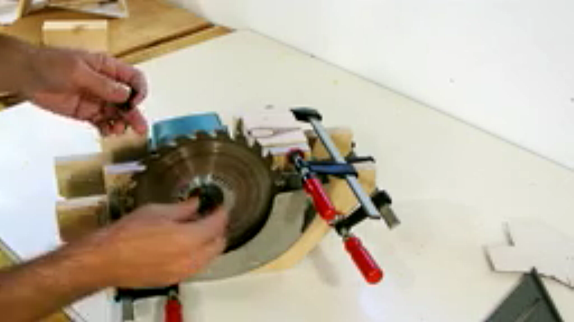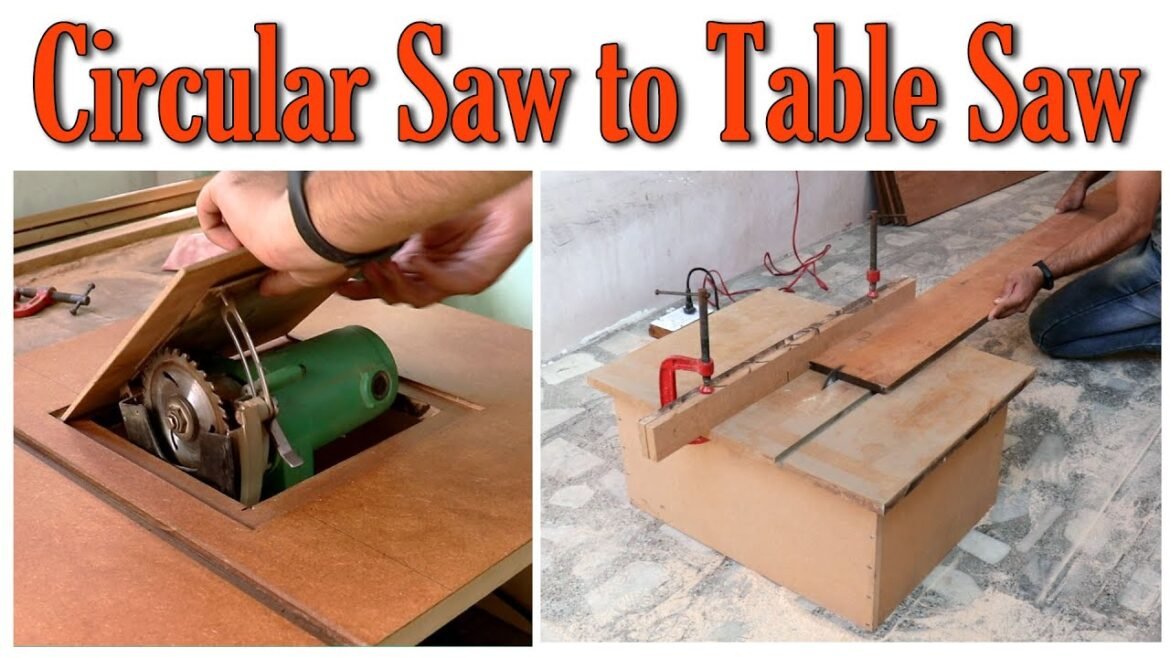Table of Contents
To turn a circular saw into a table saw, mount it upside-down beneath a flat, sturdy surface. Secure the saw firmly for safe operation.
Transforming a circular saw into a table saw can be a cost-effective solution for woodworking enthusiasts. This conversion allows for more precise cuts and improved stability during projects. Start by selecting a robust, flat surface to serve as the table.
The saw should be securely fastened underneath this surface, with the blade protruding through a slot. Ensure the setup is stable and safe before use. This DIY project enhances your workshop’s versatility without investing in a dedicated table saw. By following proper safety measures, you can achieve professional results with your modified equipment.
The Drive To Diy: Circular Saw Conversion
A table saw setup provides better precision. It ensures straight cuts every time. You can handle larger pieces of wood easily. Your projects will be more professional. Using a table saw saves time and effort. It also enhances safety during cutting tasks. The saw remains stable and fixed.
Consider a conversion if you need to work on bigger projects. A circular saw can be limited. A table saw is more versatile. It is ideal for frequent and diverse cuts. Converting is useful if you want better accuracy. It can also be a cost-effective solution. You won’t have to buy a new table saw.
Essential Tools And Materials
Transform your circular saw into a table saw with essential tools like clamps, a sturdy workbench, and precision measuring equipment. Ensure safety and accuracy by using quality materials such as a flat plywood base and secure mounting brackets.
Safety First: Protective Gear
Safety is very important. Always wear safety glasses. Use ear protection to save your ears. Gloves protect your hands from cuts. A dust mask helps you breathe clean air. Wear a safety helmet for head protection. Steel-toed boots protect your feet from heavy objects. Do not forget to wear a full-face shield for extra safety.
Gathering Your Equipment And Supplies
You will need a circular saw. Get a sturdy table to mount the saw. Use clamps to hold the saw in place. A ruler helps measure your cuts. A pencil is needed to mark your lines. Screws and bolts keep everything secure. A screwdriver is needed to tighten the screws. Sandpaper smooths the edges. Do not forget the power strip to plug in your tools.
Planning Your Workspace
Pick a spot with lots of space. Make sure the area is well-lit. Good lighting helps you see clearly. Ensure there is enough room for long wood pieces. Clear out any clutter to avoid accidents. Choose a place with a flat surface. This helps keep your saw stable.
Keep the saw in the center of the workspace. This allows easy access from all sides. Arrange tools and materials nearby. Store them within arm’s reach. Maintain a clean workspace to avoid hazards. Ensure the floor is not slippery. Use mats if needed for better grip.

Credit: m.youtube.com
Designing The Conversion
Transform a circular saw into a table saw with simple steps and boost your woodworking efficiency. Discover the process to create a stable, accurate cutting surface for all your projects.
Blueprints And Measurements
Start with a clear plan. Draw blueprints of your table saw design. Measure your circular saw carefully. You need to know its dimensions. This will help you create an accurate plan. Make sure to include all parts. These include the saw blade, the motor, and the base. Check each measurement twice. This ensures everything will fit together perfectly.
Custom Features And Adjustments
Think about any special features. You might want to add a dust collection system. This keeps your workspace clean. Consider a safety switch for extra protection. Adjust the height of the table. Make it comfortable for you to use. Maybe add wheels. This makes it easy to move your table saw around. Customize to fit your needs.
Building The Base And Mounting The Saw
A strong base is very important. Use thick plywood or solid wood. Cut the wood to the size you need. Use screws to join the wood pieces. Make sure everything is tight and strong. This base will hold your saw and keep it steady.
Place the circular saw under the base. Align the blade with a slot in the table. Use brackets to secure the saw to the base. Make sure the saw does not move. Tighten all the screws well. Now your saw is ready to use as a table saw.
.jpg)
Credit: ibuildit.ca
Alignment And Calibration
Transform your circular saw into a table saw by ensuring precise alignment and calibration. Achieve accurate cuts with proper setup and adjustments.
Precision In The Setup
Proper alignment is key for accurate cuts. Use a straight edge to check the saw blade. Align it perfectly with the table surface. Small errors can cause inaccurate cuts. Adjust the blade until it is straight. A ruler can help ensure precise measurement.
Ensure the fence is parallel to the blade. This prevents binding and kickback. Test the fence with a square tool. Make adjustments as needed. Tighten all bolts securely. Recheck the alignment after tightening.
Testing And Fine-tuning
Conduct test cuts on scrap wood. Check for smooth edges and straight lines. If cuts are not perfect, make small adjustments. Re-test until the saw cuts accurately. Pay attention to the blade height. Adjust it to match the material thickness. This ensures clean cuts.
Listen for unusual sounds. They may indicate misalignment. Inspect the saw and table regularly. Keep them clean and free of debris. Regular maintenance ensures long-lasting performance.
Safety Measures And Precautions
Always use a blade guard to protect yourself. The guard should cover the entire blade. Make sure the guard moves freely. Check for any obstructions. A clear guard gives better visibility. Regularly inspect the guard for damage.
An emergency off-switch is crucial. Place it within easy reach. This switch should be big and red. Test it frequently to ensure it works. Label the switch clearly. Teach others how to use it. Quick access can prevent accidents.
Maintenance And Upkeep
Clean your saw regularly to keep it working well. Use a soft brush to remove dust. Wipe the surface with a damp cloth. Ensure no moisture stays on the saw. Dry it completely after cleaning. Lubricate moving parts to prevent rust. Keep the table free from debris.
Inspect the blade before each use. Check for any damage or wear. Replace the blade if it is dull or chipped. Use the right blade for the material. Tighten the blade securely. Keep spare blades handy for quick changes. Always follow the manufacturer’s instructions.
Advanced Modifications
A rip fence helps in making straight cuts. First, measure the distance from the blade to the edge. Next, attach a sturdy piece of wood parallel to the blade. Ensure it is secure and does not move. This will act as your guide. Make sure the fence is parallel to the blade. This prevents any uneven cuts.
A miter gauge is useful for angled cuts. Start by attaching the gauge to the saw table. It should slide smoothly along a groove. Make sure it is adjustable for different angles. This allows for precise cuts. Always double-check the angle before cutting. This ensures accuracy.
Project Showcase: Completed Diy Table Saw
The completed DIY table saw works very well. It can cut wood with high precision. The saw is strong and stable. It is safe to use with proper care. The table saw can cut through thick and thin wood. It is useful for many projects. The saw’s blade is sharp and fast. It makes clean and smooth cuts.
Building the table saw was fun and educational. It took some time and effort. The project needed careful planning and attention to detail. Mistakes were part of the learning process. Fixing them helped improve the skills. The final result was worth the work. The DIY table saw is a great addition to any workshop.

Credit: hackaday.com
Frequently Asked Questions
Can I Make A Circular Saw Into A Table Saw?
Yes, you can convert a circular saw into a table saw. Secure the saw beneath a table with the blade protruding through a slot. Ensure stability and safety.
Can A Circular Saw Do The Same As A Table Saw?
A circular saw can perform many tasks of a table saw but lacks precision and stability. For detailed cuts, a table saw is better.
Can I Convert My Circular Saw Into A Track Saw?
Yes, you can convert a circular saw into a track saw. You need a compatible track and mounting kit.
Can Circular Saw Blades Be Used In Table Saws?
Yes, circular saw blades can be used in table saws. Ensure the blade size and arbor match your table saw specifications.
Conclusion
Transforming a circular saw into a table saw is a practical and cost-effective solution. It enhances your woodworking capabilities without breaking the bank. With careful planning and safety measures, this DIY project can boost your workshop efficiency. Save money and expand your toolset with this clever modification.
